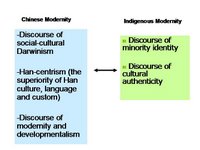[Week 12/ Case study I: Tourism and cultural identities]
1. Classical anthropology: A special kind of “tourism”
1.1. An elite culture and colonial gaze
1.2. One-way communication
1.3. “The other” : An authentic, stable and isolated entity.
1.4. Ethnographic “present”, an imagined “past”
 2.Tourism as a consequence of modernity (Sydney White D. 1997)
2.Tourism as a consequence of modernity (Sydney White D. 1997)2.1. Natives are negotiating their identities with colonialism and modernity
2.2. The new situations of ethnic minorities
-The minority groups are not isolated from the world outside.
-They are affected by dominant discourses, particularly those advocated by the state.
2.3. Naxi (納西族) in Lijiang
-Dayan(大研) as the centre of the Naxi people
2.4. Chinese and indigenous modernity
-Naxi people think they are superior to other minorities in terms of… …
 *Economic achievement
*Economic achievement*Hygienic measures
*Custom (relative to Mosuo)

2.5. Dayan-Naxi centrism:
-Dayan as a modern centre compared to “backward” and “clean” peripheries.
(Han culture becomes a standard)
-Dayan town is less authentic than the remote Naxi villages with cultural authenticity.
2.6. Gender and modernity:
-Naxi Man: “Fame” and hierarchy
-Naxi Woman: Suffering, Sacrifice and Authenticity
2.7. Identities in two discourses
-Situating themselves in the discourse of modernity
-Locating themselves in the discourse of cultural authenticity
2.8. Mosuo
-Valorize and emphasize on cultural authenticity.
*Non-commercial
*Matriarchy
*Non-urban
*Traditional attire
*“Minority-ness”
-Situating themselves in modernity:
*Develop tourism
*Equal relationship
*Aestheticize custom
*Criticizing the modern world
2.9. What is culture?
-Culture as the process and consequence of modern and colonial encounter
2.10. One more example: The Yi (彝族) people in Yuanyang
3. Performing modernity and tradition (Louisa Schein 1999)
3.1.What is culture?
-Malinowski: culture as institution in the everyday life
-Geertz: culture is a complexity of symbolic structures
-Malinowski: Identity is determined by social institutions (sociological identities)
-Geertz: Identity is determined by symbolic structures.
3.2. Tourism and identities
-Identity becomes a toured object.
-Identity becomes an object of self-conscious display and hence control (p. 380).
“What was being done when Miao took up their culture and remarked on, observed, consumed, critiqued, or otherwise engaged it, not as what Malinowski called the “imponderabilia of actual life”, but instead self-consciously and from some measure of distance?”
3.3. Culture is ......
-How they take up their “culture’
-How they talk about and look at it
-How they consume it.
-How they criticize it.
-Culture as a series of performance
4. The impact of tourism on anthropology
4.1. The object of analysis shifts from the "field" to cultural negotiation
4.2. From indigenous/ aboriginal/ authentic culture to "the local"
4.3. Study the local. But what is "the local"?
-The local is not the past waiting to be discovered
-The local people locate themselves in trans-local spaces
4.4. Culture, fieldwork and modes of travelling
-Fieldwork is a travelling process
-Ethnographic knowledge depends on modes of travelling
-Tourism and tourists (including ethnographer) become significant parts of culture

0 Comments:
Post a Comment
<< Home